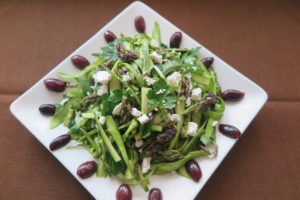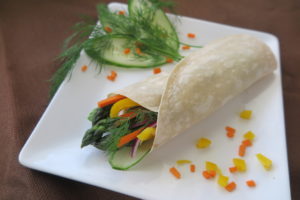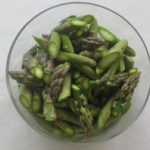Ah! It’s Asparagus Time!
Let the growing season begin! Asparagus is the first vegetable to enlighten us with the treasured local produce the upcoming summer will provide. The season isn’t long, about 6-7 weeks. So don’t miss a moment, it’s worthy of eating often.
Michigan is the second largest producer of asparagus in the United States, second to California with the state of Washington following us. The sandy soil of Michigan’s west coast is ideal for this very special vegetable. Did you know that asparagus is actually in the lily family? It originated in the Mediterranean area, prized for its medicinal and aphrodisiac qualities.
There are 120 family asparagus farms in Michigan. They grow 20 million pounds on 9500 acres of land. It takes patience and a lot of hard work to grow asparagus. It takes four years for the plant to mature to the point you can harvest it. Each field is picked by hand, 25-35 times during the growing season. This adds up to be about 500 million asparagus spears! Once the plant gets going, they go fast, being able to grow ½ inch per hour in the most ideal conditions.
These beautiful spears are packed full of vitamins and mineral and are very low in fat and calories. Trying to drop a couple pounds after the winter? Asparagus is just the thing for you. Its high fiber content keeps the hunger cravings at bay. It’s full of antioxidants. Studies have shown that it’s a mood lifter, a bloat reducer, can ease the symptoms of “one more glass of wine”, and don’t forget those rumors of an aphrodisiac. It sounds like the miracle vegetable!
There is no other vegetable that compares in flavor and beauty. It comes in green, purple and white. Purple is new, a product of conventional plant breeding (not GMO!). Its popularity makes it harder to find. When cooked, they turn dark green. The white asparagus has not been exposed to the sun, not going through photosynthesis. They are dug up before their spear pokes out of the ground.
Size doesn’t matter. A thin asparagus spear does not mean it’s younger or tenderer. The outer skin is the same thickness on a thin spear as it is on a thicker spear. The flavor is identical. However, thin spears are better for stir-frying and sautéing, thick spears are better for roasting and grilling. Medium size spears can be cooked anyway you want.
When buying asparagus, look for spears that have a bright color and a tight tip. When you get them home, cut a thin slice off the bottom of the spears. Place in a glass of water with an inch and a half of water. Keep it uncovered in your refrigerator. It’s a living plant and needs to drink up the water to keep it fresh and crisp. Before preparing or cooking, remove the tougher bottom portion of the spear. Hold on to the spear with both hands toward the bottom. Gently bend and it will snap at the perfect point of tenderness.
This miraculous plant can be eaten raw or cooked. When it comes to cooking, the world is your spear! Sauté, steam, blanched, stir-fry, roast, broil, grill. What to prepare it with? Anything goes. Frittatas, Quiche, Pasta, Rice, Soup, Salads, Pesto, Hummus, Tempura. And, this lovely little treasure can be eaten with just a little salt and pepper, can be spiced up with red pepper flakes, is not opposed to be being topped with a luscious sauce or just some fresh squeezed lemon juice. It doesn’t mind sharing the dinner plate with a juicy steak, a delicate piece of fish/seafood or a spicy barbeque rib.
It’s all too good to be true! Too bad the season is so short!
Try out these fun recipes:





